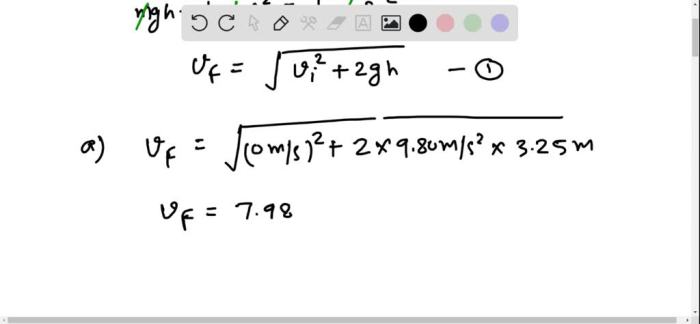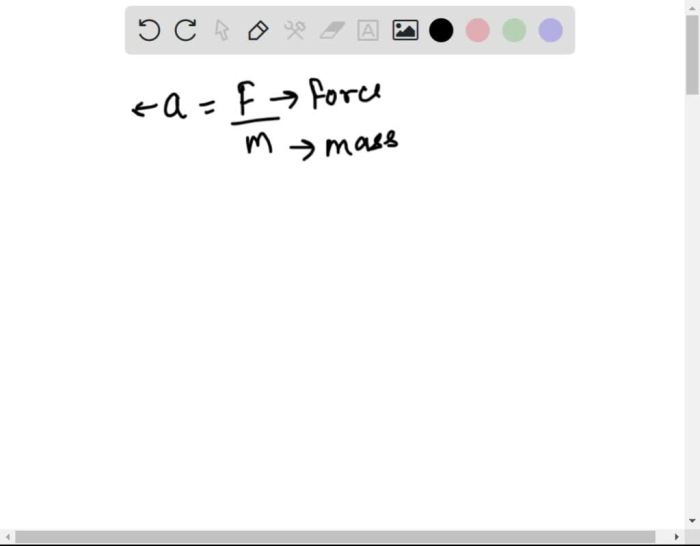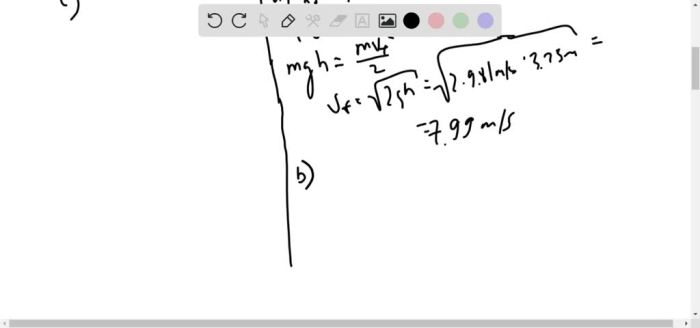If a 70 kg swimmer pushes against the water, a symphony of physical forces unfolds, shaping their movement and propelling them through the aquatic realm. From buoyancy to drag and propulsion, this article delves into the intricacies of pushing in swimming, providing insights that can enhance performance and optimize training.
As the swimmer’s body interacts with the water, a complex interplay of forces comes into play, influencing their speed, efficiency, and overall swimming experience.
Physical Implications of Force Exerted

When a 70 kg swimmer pushes against water, they generate a force that propels them forward. This force is influenced by several physical factors, including buoyancy, drag, and propulsion.
Buoyancy
Buoyancy is the upward force exerted by a fluid that opposes the weight of a submerged object. In the case of a swimmer, buoyancy counteracts the force of gravity, making it easier for them to stay afloat. The magnitude of the buoyant force is equal to the weight of the water displaced by the swimmer’s body.
Drag, If a 70 kg swimmer pushes
Drag is the force that opposes the motion of an object through a fluid. For a swimmer, drag is created by the friction between their body and the water. The magnitude of drag depends on the swimmer’s velocity, body shape, and surface area.
Propulsion
Propulsion is the force that drives a swimmer forward. It is generated by the swimmer’s arm and leg movements, which push against the water. The magnitude of propulsion depends on the swimmer’s strength, technique, and coordination.
Swimmer’s Technique and Body Position
The effectiveness of a swimmer’s push is influenced by their technique and body position. A streamlined body position reduces drag, while a powerful arm and leg stroke generates more propulsion. Swimmers can also use their body position to create additional buoyancy, such as by tucking their chin to their chest.
Water Resistance and Drag
When a swimmer moves through water, they encounter resistance due to the fluid’s viscosity and the shape of their body. This resistance, known as drag, can significantly impact the swimmer’s speed and efficiency.
Role of Water Viscosity
Water is a viscous fluid, meaning it resists flow. As a swimmer moves through the water, the layers of water immediately surrounding their body stick to their skin, creating a boundary layer. The thicker this boundary layer, the greater the drag.
The viscosity of water increases with temperature, so swimmers may experience more drag when swimming in warmer water.
Body Shape and Drag
The shape of a swimmer’s body also affects drag. A streamlined body with a small frontal area will experience less drag than a bulky body with a large frontal area. Swimmers with a narrow waist and broad shoulders have a more streamlined shape and, therefore, experience less drag.
Strategies for Reducing Drag
Swimmers can employ various strategies to reduce drag and improve their efficiency in the water. These strategies include:
- Maintaining a streamlined body position:Keeping the body straight and aligned with the direction of movement reduces the frontal area and minimizes drag.
- Wearing a swimsuit designed for reduced drag:Specialized swimsuits made from low-drag materials and featuring a streamlined design can significantly reduce drag.
- Using fins or paddles:Fins and paddles can help propel the swimmer forward while reducing drag by increasing the surface area in contact with the water.
Propulsion and Energy Conservation

Propulsion in swimming is achieved by pushing against water, generating a force that propels the swimmer forward. The relationship between force, velocity, and energy conservation plays a crucial role in this process.
If a 70 kg swimmer pushes against a wall, the force they exert is proportional to their mass. Incidentally, the omega psi phi dog collar is a stylish accessory for your canine companion. Returning to the swimmer, the force they apply is also affected by the surface area of their hands.
The force applied by the swimmer against water creates a reaction force that propels them forward, according to Newton’s third law of motion. The magnitude of this force determines the acceleration of the swimmer, and hence their velocity. However, water exerts a resistive force on the swimmer, known as drag, which opposes their motion.
Energy Conservation
Energy conservation principles apply to swimming as well. The swimmer’s kinetic energy, which is the energy of motion, is derived from the chemical energy stored in their muscles. As the swimmer pushes against water, they expend energy, which is converted into kinetic energy.
However, some of this energy is lost to drag and other inefficiencies, resulting in a decrease in velocity.
To maximize propulsion and conserve energy, swimmers employ various techniques, such as streamlining their body, reducing drag by wearing specialized swimsuits, and using efficient stroke techniques that minimize energy loss.
Fluid Dynamics and Flow Patterns: If A 70 Kg Swimmer Pushes

Understanding fluid dynamics is crucial for swimmers to optimize their technique and efficiency in the water. As a swimmer pushes off from the wall, they interact with the water, creating complex flow patterns that influence their propulsion.
Formation of Vortices and Eddies
As the swimmer’s body moves through the water, it creates areas of high and low pressure. These pressure gradients result in the formation of vortices, swirling regions of water that rotate around an axis. Eddies, smaller and more chaotic vortices, also form behind the swimmer’s body.
Role of Fluid Dynamics in Swimming Technique
Understanding fluid dynamics allows swimmers to identify areas where they can reduce drag and improve propulsion. For example, by streamlining their body and reducing surface area, swimmers can minimize the formation of vortices and eddies, reducing resistance.
Additionally, by studying flow patterns, swimmers can determine the optimal timing and angle of their push-offs, maximizing their forward momentum and minimizing wasted energy.
Body Mechanics and Technique
Effective pushing in swimming requires optimal body position and technique. This involves maintaining a streamlined posture, engaging core muscles for stability, and coordinating movements for maximum propulsion.
Role of Core Strength, Flexibility, and Coordination
A strong core provides a stable base for powerful pushes. Flexibility allows for greater range of motion, enabling the swimmer to extend their arms fully. Coordination between arms, legs, and core muscles ensures efficient energy transfer and propulsion.
Drills and Exercises
- Dolphin Kicks:Improves core strength and leg flexibility.
- Pull-ups:Develops back and core muscles.
- Swim-Specific Exercises:Practice the push-off technique using resistance bands or in-water drills.
Applications and Implications

Understanding the mechanics of pushing in swimming has far-reaching practical applications that extend beyond the pool. This knowledge empowers coaches, athletes, and researchers to optimize training programs, enhance performance, and safeguard swimmers from injuries.
Improved Training Programs
- By analyzing the biomechanics of pushing, coaches can identify areas for improvement in an athlete’s technique. This enables them to tailor training programs that specifically address these areas, leading to more efficient and effective training.
- Understanding the relationship between push force and body position allows coaches to design drills that enhance the swimmer’s ability to generate power and propulsion.
- Research on pushing in swimming has also contributed to the development of training equipment, such as resistance bands and paddles, that can simulate the forces experienced during actual swimming.
Optimized Swimming Performance
- A thorough understanding of pushing mechanics enables swimmers to refine their technique and maximize their efficiency in the water. This can lead to improved speed, endurance, and overall performance.
- By understanding how different body positions and movements affect push force, swimmers can optimize their stroke mechanics to reduce drag and increase propulsion.
- Research on pushing in swimming has also shed light on the role of core strength and stability in generating power during the push phase, which has led to the development of specific exercises to improve these qualities.
Injury Prevention
- Understanding the mechanics of pushing can help prevent injuries by identifying and addressing potential risk factors. For example, improper technique can put excessive strain on joints and muscles, leading to pain and discomfort.
- By teaching swimmers proper pushing technique, coaches can help reduce the risk of common injuries, such as shoulder impingement, back pain, and knee pain.
- Research on pushing in swimming has also contributed to the development of injury rehabilitation protocols that focus on restoring proper mechanics and preventing re-injury.
Key Questions Answered
What is the primary force that propels a swimmer forward?
The primary force propelling a swimmer forward is the force they exert against the water by pushing with their arms and legs.
How does a swimmer’s body position affect their propulsion?
A streamlined body position reduces drag and allows the swimmer to push against the water more effectively, resulting in greater propulsion.
What role does drag play in swimming?
Drag is the resistance encountered by the swimmer’s body as it moves through the water. Reducing drag is crucial for optimizing swimming efficiency and speed.